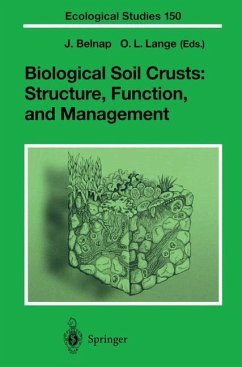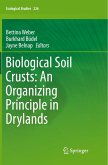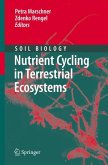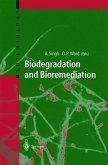In arid lands, where vegetation is sparse or absent, the open ground is not bare but generally covered by a community of small, highly specialized organisms. Cyanobacteria, algae, microfungi, lichens, and bryophytes aggregate soil particles to form a coherent skin - the biological soil crust. It stabilizes and protects the soil surface from erosion by wind and water, influences water runoff and infiltration, and contributes nitrogen and carbon to desert soils. Soil surface disturbance, such as heavy livestock grazing, human trampling or off-road vehicles, breaks up the fragile soil crust, thus compromising its stability, structure, and productivity. This book is the first synthesis of the biology of soil crusts and their importance as an ecosystem component. Composition and functioning of different soil-crust types are discussed, and case studies are used to show the impact of crusts on landscape hydrology, soil stability, nutrient cycles, and land management.
In arid and semiarid lands throughout the world, where the cover of vegetation is sparse or absent,the open spaces between the higher plants are generally not bare of autotrophic life,but covered by a community of highly specialized organisms. This soil-surface community consists of cyanob- teria, algae, lichens, mosses, microfungi, and other bacteria in differing proportions. Cyanobacterial and microfungal filaments, rhizinae and rhi- morphs of lichens, and the rhizinae and protonemata of bryophytes weave throughout the top few millimeters of soil,gluing loose soil particles together. This forms a crust up to a few centimeters thick that stabilizes and protects soil surfaces from erosive forces (Cameron and Blank 1966; Friedmann and Galun 1974; Belnap and Gardner 1993).These crusts occur in all hot,cool,and cold-arid and semiarid regions of the world,and may constitute up to or more than 70% of the living cover. Biological soil crusts have only recently been recognized as havinga major influence on terrestrial ecosystems.
In arid and semiarid lands throughout the world, where the cover of vegetation is sparse or absent,the open spaces between the higher plants are generally not bare of autotrophic life,but covered by a community of highly specialized organisms. This soil-surface community consists of cyanob- teria, algae, lichens, mosses, microfungi, and other bacteria in differing proportions. Cyanobacterial and microfungal filaments, rhizinae and rhi- morphs of lichens, and the rhizinae and protonemata of bryophytes weave throughout the top few millimeters of soil,gluing loose soil particles together. This forms a crust up to a few centimeters thick that stabilizes and protects soil surfaces from erosive forces (Cameron and Blank 1966; Friedmann and Galun 1974; Belnap and Gardner 1993).These crusts occur in all hot,cool,and cold-arid and semiarid regions of the world,and may constitute up to or more than 70% of the living cover. Biological soil crusts have only recently been recognized as havinga major influence on terrestrial ecosystems.
From the reviews:
"The authors use amazing original pictures to show the structure, the extraordinary diversity and the natural beauty of the biological soils crusts. ... The bibliography is very rich and up-to-date ... The extensive taxonomic index with 1100 taxa and the subject index with 570 keywords provides quick access to various topics and problems. Written by leading experts, this book is a comprehensive presentation and the first global synthesis of the biology of soil crusts and their importance as an ecosystem component. Summing up, the volume can be recommended to a wide readership; it should be accessible to all research groups interested in botany, plant physiology, ecology or conservation biology. Considering the large number of good colour illustrations, the price of the book is not high at all." (Community Ecology)
"This book is the first attempt to summarize the knowledge on biology, biodiversity, ecology and management of biological soil crusts ona global scale. I believe the authors have succeeded admirably. ... This important book will surely inspire others to broaden our knowledge of these widely distributed and still relatively little known communities. ... It is highly recommended to everybody interested in any aspect of the ecology of hot and cold deserts. Lichenologists, bryologists and microbiologists will find new challenges in their respective disciplines and ecologists will be inspired by these apparently simple ecosystems." (The Lichenologist)
From the reviews of the hardcover edition
"This is a wide and comprehensive review of the subject that deserves a place in a research library." (Bulletin of the British Ecological Society)
"Congratulations to the editors and contributors for presenting this clearly organized, and in general very fascinating book." (Phytocoenologia)
"This volume was unusually well coordinated for an edited book with many diverse authors. Belnap and Lange clearly selected authors and topics carefully to provide as wide a coverage of topics as possible, and placed a heavy emphasis on integration and synthesis. ... Even at the high price, this is a good book to own." (Ecology)
"Given current concerns over rangeland management in arid environments, this book is very topical and should be a valuable reference for resource managers and scientists alike. The publication of Biological Soil Crusts: Structure, Function, and Management marks an important milestone in the recognistion of these unique ecological communities." (The Bryologist)
"This book is the first attempt to summarize the knowledge on biology, biodiversity, ecology and management of biological soil crusts on a global scale. I believe the authors have succeeded admirably. ... This important book will surely inspire others to broaden our knowledge of these widely distributed and still relatively little known communities. ... Therefore, it is highly recommended to everybody interested in any aspect of the ecology of hot and cold deserts." (Leopoldo G. Sancho, The Lichenologist, Vol. 36 (1), 2004)
"This book had its genesis as a part of the series 'Ecological Studies' ... . The authors use amazing original pictures to show the structure ... and the natural beauty of the biological soil crusts. ... this book is a comprehensive presentation and the first global synthesis of the biology of soil crusts and their importance as an ecosystem component. ... can be recommended to a wide readership: it should be accessible to all research groups interested in botany, plant physiology, ecology or conservation biology." (Zs. R. Benkö, Community Ecology, Vol. 4 (1), 2003)
"The authors use amazing original pictures to show the structure, the extraordinary diversity and the natural beauty of the biological soils crusts. ... The bibliography is very rich and up-to-date ... The extensive taxonomic index with 1100 taxa and the subject index with 570 keywords provides quick access to various topics and problems. Written by leading experts, this book is a comprehensive presentation and the first global synthesis of the biology of soil crusts and their importance as an ecosystem component. Summing up, the volume can be recommended to a wide readership; it should be accessible to all research groups interested in botany, plant physiology, ecology or conservation biology. Considering the large number of good colour illustrations, the price of the book is not high at all." (Community Ecology)
"This book is the first attempt to summarize the knowledge on biology, biodiversity, ecology and management of biological soil crusts ona global scale. I believe the authors have succeeded admirably. ... This important book will surely inspire others to broaden our knowledge of these widely distributed and still relatively little known communities. ... It is highly recommended to everybody interested in any aspect of the ecology of hot and cold deserts. Lichenologists, bryologists and microbiologists will find new challenges in their respective disciplines and ecologists will be inspired by these apparently simple ecosystems." (The Lichenologist)
From the reviews of the hardcover edition
"This is a wide and comprehensive review of the subject that deserves a place in a research library." (Bulletin of the British Ecological Society)
"Congratulations to the editors and contributors for presenting this clearly organized, and in general very fascinating book." (Phytocoenologia)
"This volume was unusually well coordinated for an edited book with many diverse authors. Belnap and Lange clearly selected authors and topics carefully to provide as wide a coverage of topics as possible, and placed a heavy emphasis on integration and synthesis. ... Even at the high price, this is a good book to own." (Ecology)
"Given current concerns over rangeland management in arid environments, this book is very topical and should be a valuable reference for resource managers and scientists alike. The publication of Biological Soil Crusts: Structure, Function, and Management marks an important milestone in the recognistion of these unique ecological communities." (The Bryologist)
"This book is the first attempt to summarize the knowledge on biology, biodiversity, ecology and management of biological soil crusts on a global scale. I believe the authors have succeeded admirably. ... This important book will surely inspire others to broaden our knowledge of these widely distributed and still relatively little known communities. ... Therefore, it is highly recommended to everybody interested in any aspect of the ecology of hot and cold deserts." (Leopoldo G. Sancho, The Lichenologist, Vol. 36 (1), 2004)
"This book had its genesis as a part of the series 'Ecological Studies' ... . The authors use amazing original pictures to show the structure ... and the natural beauty of the biological soil crusts. ... this book is a comprehensive presentation and the first global synthesis of the biology of soil crusts and their importance as an ecosystem component. ... can be recommended to a wide readership: it should be accessible to all research groups interested in botany, plant physiology, ecology or conservation biology." (Zs. R. Benkö, Community Ecology, Vol. 4 (1), 2003)








